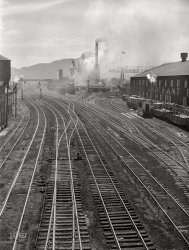
MAY CONTAIN NUTS

Search Shorpy
SHORPY ART

Framed or unframed, desk size to sofa size, printed by us in Arizona and Alabama since 2007. Explore now.
Join and Share
Ad-Free Shorpy
Shorpy is funded by you. Patreon contributors get an ad-free experience.
Learn more.

Recent comments
- S&P
- 1940 Zenith radio model 6G601
- Quality goes in before the name goes on!
- Snazzy skirt
- Carbon Arc Lamps
- Illuminate us
- I remember it well
- I can't prove it
- Complicated then, forgotten now
- Bryan-Stevenson
- Skinny is as skinny does
- How do you rest in peace
- Riding the footboards
- Alas, hidden from view
- Baldwin Diesels
- Exclusive pump
- Bananas, Oysters and Smokey Joe
- Details, Details
- What's that building to the left of the tower?
- Coal Barges
- Bromo-Seltzer
- Inner harbor
- The Basin
- What a headache!
- Giant stepladder?
- Yeah, it was cold
- Love those coats
- Link & Pin Days Remnant
- Baldwin 62303
- Baldwin VO-1000
Member Photos
The Shorpy
Print Emporium
Print Emporium
Search Shorpy
Search results -- 30 results per page
- Casino Matinee: 1935
- ... full size. 35mm nitrate negative by Ben Shahn for the Farm Security Administration.
Paramount News - War Rages The smiles, the ... Posted by Dave - 07/29/2008 - 10:42pm -
![Casino Matinee: 1935 October 1935. Matinee at the Casino Cinema in Amite City, Louisiana. Among the current offerings: Laurel and Hardy in "Tit for Tat." View full size. 35mm nitrate negative by Ben Shahn for the Farm Security Administration.
Paramount News - War RagesThe smiles, the laughter, little did these poor people know what awaited them a few short years hence. Though the writing was on the wall.
At the MoviesBesides "Tit for Tat" they're currently showing "Stolen Harmony" with George Raft. Raft plays an sax playing ex-con who joins up with a big band led by someone who was not Ben Bernie, but was only played by the big band leader. Raft, who was famous for playing gangsters in movies (and for being a friend to people like Bugsy Siegel and Al Capone), must have loved this picture because it gave him a chance to dance, which was how he'd made his living before he got into movies.
Unfortunately no amount of fiddling (at least none that I'm capable of) is able to bring up the name of the Next Attraction (Tuesday) but they've got "David Copperfield" with Freddie Bartholomew, Edna May Oliver, Lionel Barrymore and W.C. Fields (in a part that he coveted) coming in. This, combined with "Tit For Tat," would seem to indicate that The Casino showed mostly MGM movies (though "Stolen Harmony" was a Paramount title).
[Next Attraction is "Rendezvous at Midnight." - Dave]
I'm complaining to the managementThe Personal History, Adventures, Experience, & Observation of David Copperfield the Younger aka David Copperfield was released January 18, 1935. (MGM)
Rendezvous at Midnight was released February 11, 1935. (Universal)
Tit for Tat was released January 5, 1935. (MGM distributed for Hal Roach Studios)
Stolen Harmony was released April 20, 1935 (der Fuhrer's 46th birthday). (Paramount)
Italy invaded Ethiopia Oct. 3, 1935.
The Casino must've run Gone With The Wind sometime in 1942.
Movie PrintsRemember the studios didn't strike as many prints of any given movie then as they do now. Today it's all about getting the movie into as a many screens as you can book it into on opening weekend and then hope you can keep it there for more than a couple of weeks. In those days movies opened in the big cities and then the same prints would trickle down to the smaller markets.
You are right about "Gone With The Wind" though. Although the movie premiered in December 1939 (just making it into that mythical year for the movies) it was strictly an advanced ticket road show presentation seen only in a limited number of theaters (156 in February 1940 according to Wikipedia). It didn't enter general release until 1941, so for a small town theatre like the Casino, 1942 is probably a good bet.
(The Gallery, Ben Shahn, Kids, Movies, Small Towns)](https://www.shorpy.com/files/images/8a17044u.thumbnail.jpg)
- Welcome to Cokeville: 1941
- ... Georgia." Medium format negative by Jack Delano for the Farm Security Administration. View full size.
The Corner Report How ... Posted by Dave - 12/10/2018 - 10:17pm -
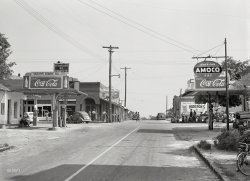
- Extra-Lardge: 1938
- October 1938. "Farm wife. Burlington County, New Jersey." Photo by Arthur Rothstein for the Farm Security Administration. View full size.
Extra hard I like the look on this ... Posted by Dave - 11/15/2017 - 10:44am -
![Extra-Lardge: 1938 October 1938. "Farm wife. Burlington County, New Jersey." Photo by Arthur Rothstein for the Farm Security Administration. View full size.
Extra hardI like the look on this person’s face. Despite the apparently harsh circumstances, and it can’t be easy carrying around all that extra weight, there is an engaging quality in her smile-grimace that lets us know she has a strong and positive spirit. (And, as usual, she’s probably 10 years younger than I think she is.)
Pig slop?Despite the fact that the lady looks a lot like Farmer Hoggett’s wife in the movie Babe, l’m guessing this will be for the pigs.
Cheap ShotWhat a great photo of a kindly looking woman! Too bad you decided to take the low road in your presentation of this photograph.
[Maybe you're reading that wrong. - Dave]
Bless her heartShe looks just like my great Aunt Zazel. I bet she used that lard to make some delicious food, too. And you can tell by the way she's dressed that, despite her being overweight, she probably worked as hard as any man. Reminds me of Auntie Em in the Wizard of Oz handing out cornbread to the farmhands.
(The Gallery, Arthur Rothstein, Kitchens etc.)](https://www.shorpy.com/files/images/SHORPY-8b17212a.thumbnail.jpg)
- Let's Eat: 1939
- ... Medium-format nitrate negative by Dorothea Lange for the Farm Security Administration.
Older than the USA Amazing, the history one ... Posted by Dave - 09/09/2011 - 11:35am -
![Let's Eat: 1939 July 1939. "Congregation gathers after services to talk. Wheeley's [Wheeler's?] Church, Person County, North Carolina." View full size. Medium-format nitrate negative by Dorothea Lange for the Farm Security Administration.
Older than the USAAmazing, the history one uncovers because of Shorpy.
Searching the internet finds that Wheeler's Church is in the Bushy Fork township of Person County and has one of the two cemeteries in the township. More interestingly (to me) was this article that claims the "Wheeler's Primitive Church" was founded in 1760, before the Revolutionary War.
I wonder if any of the people in Ms. Lange's photo are related to Mr. Phelps.
Short skirtsSomething I've noticed looking at historical fashion sites that often seems to be overlooked---throughout much of history--and even to some degree, perhaps regionally, up to my own childhood in the 1970s, it actually was quite normal for girls under 12 or so to wear skirts quite a bit shorter than was usually acceptable for adult women and teens. You'll see Victorian pictures where the little girls have their dresses showing their calves, while their older sisters never would, and certainly no one ever thought twice about a 7-year old in the shortest of short-shorts and a skimpy tube top when I was one. I've two theories why this could be so, and perhaps it's some of both. One is that, while pedophilia has been a problem since time began, it wasn't really thought about in everyday life much, so no one thought much more of showing a little girl's legs than of showing a baby in only a diaper. The other is simple economics( probably especially applicable in the 30s!) It's expensive and hard work keeping skirt-length growing apace with children of that age, and moreover they might not have outgrown the puddle-splashing urge and would likely ruin long skirts much more quickly.
KatieI'm surprised at the length of that skirt on the girl in the doorway. It's significantly above her knees - something that just wasn't done in church, let alone on a girl that age.
[And yet evidently it was. - Dave]
Where are the women and the boys?This could be rural Oklahoma in the late 50's, where the women and girls would be laying out a communal (potluck) Sunday dinner on picnic tables under the trees behind or to the side of the church (and possibly next to the cemetery), and the boys would be spread out across the property letting out their pent up energy after sitting through a (minimum) two-hour service. The young girls in the doorway are "tending" the men, they are there to relay messages from the men to the women and return with answers or the requested individual or item. They also function as *sentinels* for the women, in case a fight breaks out between some boys or a loud argument amongst the men.
Thank you for posting this. I had forgotten how much I love Dorothea Lange!
Getting tangled.As a lady-person, I can attest that sometimes a skirt seems shorter than it actually is--especially if the skirt is slightly pulled up by her efforts to hold the baby. Likely the girls skirt is somewhat longer (you'll notice the uneven-ness) and probably just stuck under baby and blanket.
Anyway==Great photo!
(The Gallery, Dorothea Lange, Rural America, Small Towns)](https://www.shorpy.com/files/images/8b34224u_0.thumbnail.jpg)
- Belle of the Beans: 1941
- ... Medium format acetate negative by John Vachon for the Farm Security Administration. View full size.
Maud Muller, personified ... Posted by Dave - 03/11/2020 - 7:34pm -
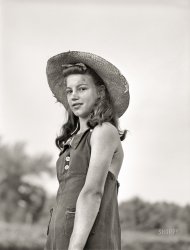
- Vincennes: 1941
- ... full size. 35mm nitrate negative by John Vachon for the Farm Security Administration.
The Old Cathedral This is Joe Manning. The Old ... Posted by Dave - 01/23/2008 - 12:36pm -
![Vincennes: 1941 July 1941. The Old Cathedral in Vincennes, Indiana. View full size. 35mm nitrate negative by John Vachon for the Farm Security Administration.
The Old CathedralThis is Joe Manning. The Old Cathedral still stands. See all about this church and parish here.
That's Vincennes, INDIANAThe Old Cathedral was recently restored (at great expense) and looks fabulous!
My wife and I would have been married in that church had it not been getting its previous painting in January of 1971.
Vincennes, IndianaSo, why not change the capture Dave? The link proves it is Indiana, isn't it?
Alex, the "state freak" (so not: "steak frites (french fries)" lol
[The caption has been changed. Thanks to everyone who helps keep Shorpy accurate. -Ken]
Vincennes 35 chevyWhat are the odds the car is a 1935 Chevrolet Master 5 window coupe they are a rare car today because the body was wrapped around a wood frame and the wood rotted away and the car was junked. Here's mine, made into a hotrod.
(The Gallery, Cars, Trucks, Buses, John Vachon, Small Towns)](https://www.shorpy.com/files/images/8a32837u.thumbnail.jpg)
- Mogollon, N.M.: 1940
- ... New Mexico." Medium format negative by Russell Lee for the Farm Security Administration. View full size.
Coronado Cuarto Centennial ... Posted by Dave - 08/08/2018 - 5:16am -
![Mogollon, N.M.: 1940 May 1940. "On the main street of Mogollon, New Mexico." Medium format negative by Russell Lee for the Farm Security Administration. View full size.
Coronado Cuarto Centennialis the slogan across the top of the 1940 NM license plate facing us, celebrating the 400th anniversary of an expedition into modern New Mexico by the Spanish explorer of that name. The slogan was intended to promote the many cultural and historical commemorative events held in that year. The tag, vivid yellow on red, features the Zuni sun symbol (the Zia) used on NM plates from 1927 to the present day. Combining all these attributes makes this license plate one of the most collectible of all.
So ...According to Wikipedia, Mogollon "was founded in the 1880s at the bottom of Silver Creek Canyon to support the gold and silver mines in the surrounding mountains. A mine called Little Fannie became the most important source of employment for the town's populus. During the 1890s Mogollon had a transient population of between 3,000 and 6,000 miners and, because of its isolation, had a reputation as one of the wildest mining towns in the West."
["Populus" ?? - Dave]
Watch your stepThere seems to be a rather deep hole at the end of the sidewalk. The two gents outside the cafe might at least put up a sign.
This ain't Mount AiryUntil this moment, I thought that "Snappy Lunch" was exclusively a Mayberry thing!
Mogie-yawnNever heard "Mogollon" pronounced by a native Spanish speaker, but the locals near the Mogollon Rim county in AZ and NM call it "mogie-yawn." Named for the Spanish Governor of New Mexico in the early 18th century, the escarpment is cut with canyons and crested with the largest ponderosa pine forest on this planet.
A beautiful place and a favored recreation locale of mine, especially the area that straddles the AZ/NM state line. Little native Apache trout live in the streams, black bear and gray wolves in the forested areas and huge elk graze the open parks. Sublime.
[See you at Big Lake. - Dave]
Welcome to the Anachronical Cafe!Visually, this is on the border of the 19th Century Wild West and modern 20th Century. Texaco and Coca Cola signs above antique boardwalks, modern traffic on millennially old dust road, an automobile in a "garage" that looks like a shelter used centuries ago by nomads etc. In the middle of this anachronistic image, two men and cat, witnessing the passing of time.
P.S. I saw the top left corner of the image and for a moment I said to myself: "look, they have a SHORPY sign on that slope of the mountain". Yes, it was not a landmark, but a watermark.
More Recent Mogollon Two buildings on the left are still present, at least in 2008, but the Shorpy sign is gone. Someone's still sitting out on the road, this time guarding the Mogollon Museum!
(The Gallery, Cars, Trucks, Buses, Cats, Russell Lee, Small Towns)](https://www.shorpy.com/files/images/SHORPY-8b25143a.thumbnail.jpg)
- One Nation Indivisible: 1941
- ... full size. 35mm nitrate negative by Russell Lee for the Farm Security Administration.
Interesting pose Interesting pose for holding ... Posted by Dave - 01/24/2008 - 12:00am -
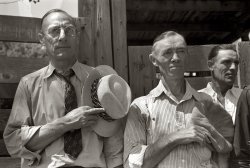
- Fourth and Main: 1941
- ... Wisconsin." 35mm nitrate negative by John Vachon for the Farm Security Administration. View full size.
Free Material My mother ... Posted by Dave - 07/04/2012 - 2:54pm -
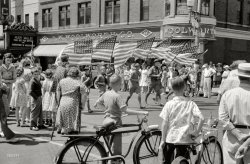
- The Best of Hurst: 1939
- ... Hurst, Illinois." Photo by Arthur Rothstein for the Farm Security Administration. View full size.
Don't have an accident! ... Posted by Dave - 08/22/2018 - 4:07pm -
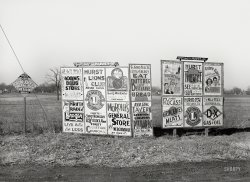
- It's Great: 1941
- ... Medium format acetate negative by Jack Delano for the Farm Security Administration. View full size.
On the wall God Bless ... Posted by Dave - 04/16/2020 - 1:09pm -
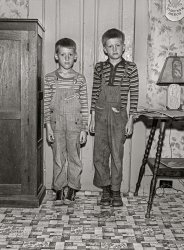
- Happiness Is: 1936
- ... California." Acetate negative by Dorothea Lange for the Farm Security Administration. View full size.
The implacable and immemorial ... Posted by Dave - 04/25/2020 - 8:36pm -
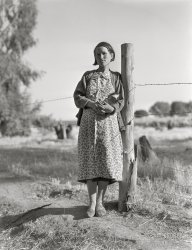
- Pull In for Pepsi: 1941
- ... Medium format acetate negative by John Vachon for the Farm Security Administration. View full size.
Breakfast, Dinner, Supper, ... Posted by Dave - 06/24/2020 - 12:18pm -
![Pull In for Pepsi: 1941 March 1941. "Four o'clock traffic. Norfolk, Virginia." Medium format acetate negative by John Vachon for the Farm Security Administration. View full size.
Breakfast,Dinner, Supper, that's what we called them, now everyone calls "supper" dinner.
[And "dinner" is lunch. - Dave]
Old Tiny LibraryThere are other words -- in cursive -- on the sign, but I can't make them out, so I'll just say I want to visit the Old Tiny Library and buy a few gifts, then go to the cafe for dinner (lunch) of a sandwich, with what my stepdad used to call a "Coke-Cola."
Granby StreetAfter reviewing this photo for a while, and taking into account this is afternoon traffic, I have to think that this is a photo of Granby Street just south of where it crosses the Lafayette River. The cars are probably returning from shifts at the Norfolk Naval Yard I am wagering.
Almost too Tiny to tell, butDoes the sign maybe say "Old Timy" library? More commonly spelled "timey" these days?
[Yes! - Dave]
Spell bindingThanks to Kines and Dave on the spelling of Old Timy -- as opposed to Tiny. To be honest I thought I saw an M as opposed to an N but the word "Timy" would not register. Guess I'm a traditionalist.
You CAN have it both waysOne establishment serving both Coke and Pepsi? This is truly a bygone era.
(The Gallery, Cars, Trucks, Buses, Eateries & Bars, John Vachon)](https://www.shorpy.com/files/images/SHORPY-8c18962a.thumbnail.jpg)
- Fruitland: 1941
- ... on a Saturday afternoon." Photo by Jack Delano for the Farm Security Administration. View full size.
Old Dobbin there I sure ... Posted by Dave - 03/01/2019 - 11:09am -
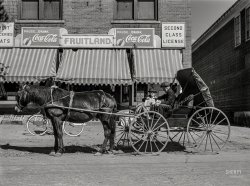
- Mom-and-Pop: 1939
- ... Iowa." Medium format negative by Arthur Rothstein for the Farm Security Administration. View full size.
"With the brown stains on ... Posted by Dave - 01/05/2018 - 11:46am -
![Mom-and-Pop: 1939 September 1939. "Popcorn stand. Grundy Center, Iowa." Medium format negative by Arthur Rothstein for the Farm Security Administration. View full size.
"With the brown stains on the bag"Indicating freshness. (Lifted from Garrison Keillor)
Those baby chicks will growif they don't plant them to deep. When I started in the Post office farmers used to get chicks and peeps delivered in the mail. We used to tell the farmers that when they came in to get the peeps. Mostly got dirty looks. Peeps were glad to go the farm. They were thirsty.
It's Dagwood!Really a startling resemblance.
[Delighted that he's in Grundy. - Dave]
Roasted PeanutsThose two boys are well dressed for the time. Also, is that a peanut roaster next to the man? It doesn't look like popcorn and I can remember something like that which was used for roasting peanuts.
Ordinary kidswith suits and ties. Haven't seen that in along time.
(The Gallery, Arthur Rothstein, Kids, Small Towns, Stores & Markets)](https://www.shorpy.com/files/images/SHORPY-8b18534a.thumbnail.jpg)
- I.G.A.: 1941
- ... Vermont." Medium format negative by Jack Delano for the Farm Security Administration. View full size.
The Dors of Perception 1936 ... Posted by Dave - 01/08/2019 - 8:11pm -
![I.G.A.: 1941 August 1941. "General store in Hinesburg, Vermont." Medium format negative by Jack Delano for the Farm Security Administration. View full size.
The Dors of Perception1936 Ford Fordor Touring Sedan. Yes, Ford spelled it Fordor & Tudor.
Somewhat changed
Orthochromatic film?The sign at the top, carefully lit with a half-dozen lights but without seeming to have any words or images could conceivably have been caused by blue paint on a white background, if it was photographed by orthochromatic film, which was still sometimes used at this time.
[There's another, simpler, explanation. - Dave]
IGA's were everywhereI remember when IGA stores were in almost every little town. When I grew up in Loomis, Nebraska, the IGA was a block from our house and up until 1975 we made our weekly grocery trips there. You could get an after-school pop there. It closed in the early 90s.
The Orthochromatic BluesIf it was orthochromatic film the blue sky would have been washed out.
Car IDs1936 Ford; 1929 Essex
The Inevitable CarOf course, there's a Subaru passing in the modern streetview image.
Hinesburg is an increasingly suburban area but still has quite a bit of working farmland for how close to Burlington it is.
(The Gallery, Gas Stations, Jack Delano, Stores & Markets)](https://www.shorpy.com/files/images/SHORPY-8c06847a.thumbnail.jpg)
- Family Room: 1941
- ... Aircraft." Medium format negative by Russell Lee for the Farm Security Administration. View full size.
Kadette K-10 A nice Kadette ... Posted by Dave - 05/19/2019 - 12:38pm -
![Family Room: 1941 May 1941. San Diego. "Family living at Kearney Mesa defense housing project. This man came out to California from Oklahoma 10 years ago. He has been an agricultural worker and had lived in various FSA camps. Now employed as a painter at Consolidated Aircraft." Medium format negative by Russell Lee for the Farm Security Administration. View full size.
Kadette K-10A nice Kadette radio in this picture. Model K-10 from 1937. Attached photo from Lynn Toppo and Radioattic. https://www.radiomuseum.org/r/intern_rc_k_101.html
Caught in the reflectionOur intrepid photographer seems to be shooting from the hip.
Role Playing Set PieceWhile the photographer futilely tries to hide from his reflection in the window, Mom and Dad have been placed in their traditional roles. Mom sits on the couch holding baby, while Dad sits to opposite side and pretends to be interested in newspaper contents.
Who was on strike?Oh no, Shorpy has done it to me again.
The newspaper headline screams about a labor union defying FDR against striking at a defense plant. I wondered: which plant, which union, and what happened?
Two clues: it is May 1941 and the plant is an aircraft facility in the LA area.
Off to Google where I found a US Department of Labor bulletin -- Number 711 dated 1942. This document listed all of the strikes from 1941.
Sure enough, there it was: the UAW (then part of the CIO) called a strike against the North American Aviation plant in Inglewood, CA on June 5th. By June 9th, FDR ordered the Army to take control of the plant and the workers returned the next day. A settlement on wages was achieved by July 1st. [page 25 of the bulletin]
The document also notes that all strikes were cancelled on 8 December.
See: https://www.bls.gov/wsp/1941_strikes.pdf
Relections and shadowsThere are two light sources evident in the photo, as best evidenced by the two shadows of the floor lamp. The shadow on the side wall is considerably off-axis from the camera angle, coming from a good distance to the right. That's the flash unit being held by the man reflected in the window. The other shadow, on the wall behind Dad, is from a light source on a very close axis to that of the camera, so close that it has to be from a flash unit mounted on the camera itself, the bulb and reflector a few inches higher than and very slightly to the left of the camera lens. Therefore, the guy in the window reflection is an assistant, not the photographer. Plus window guy would have to have third hand to click a camera shutter, since one is holding the flash and the other the white thing.
Russell LeeI can’t remember seeing a picture of him here before, even as a reflection. He was born in 1903 (and lived till 1986), so he’d be in his late thirties in this shot. I attach a photo of him from a year later, from 1942.
North American Aviation Strike - Los Angeles TimesU.S. Ready to Seize Plane Plant.
June 7, 1941: The strike at the North American Aviation plant, in which Army troops dispersed union activists and took over an essential American defense facility, is one of the landmark events in Los Angeles history.
(The Gallery, Kids, Russell Lee)](https://www.shorpy.com/files/images/SHORPY-8c35242a.thumbnail.jpg)
- Slop Sink: 1941
- ... slop sink, and garbage pail." Photo by John Vachon for the Farm Security Administration. View full size.
Car make? Ok, what is the ... Posted by Dave - 02/18/2012 - 5:49pm -
![Slop Sink: 1941 June 1941. Erie County, Pennsylvania. "Each group of ten trailers in the FSA camp at Erie has a trailer service unit, water faucet, slop sink, and garbage pail." Photo by John Vachon for the Farm Security Administration. View full size.
Car make?Ok, what is the make of that car on the right side of the photo?
[Appears to be a 1930 Durant. - tterrace]
You nailed it: 1930 Durant Model 614 Standard sedan. Thanks.
Yep, a Slop SinkDon't think I was aware of the headline term until some years ago when I bought some plumbing part to repair a fixture in my house, and was warned in the instructions, "Not for use in slop sinks." Have loved the concept ever since. The man in the photo appears to be cleaning a bucket in the slop sink, rather than installing any forbidden fittings, so he should be safe. Intriguing image from the days when '41 Pontiacs still rolled the earth.
Can on the SideNo coolant recovery sytems on that old Detroit iron back then. So between boil overs and leaky radiators, water pumps,etc. a good water can was a must.
Home Sweet HomeThat it was, for myself, Mom and Dad, for about three years in the 1940's. I believe these are the Schult trailers. (http://www.coachbuilt.com/bui/s/schult/schult.htm
We had the short model near the camera, but only one heater near the door. The trailer had only two tempertures, too hot and too cold!
(The Gallery, Cars, Trucks, Buses, John Vachon)](https://www.shorpy.com/files/images/SHORPY_8c19283u.thumbnail.jpg)
- The Pause That Refreshes: 1940
- ... Nevada." Medium format negative by Arthur Rothstein, Farm Security Administration. View full size.
Do my eyes deceive me or is ... Posted by Dave - 02/13/2018 - 10:05am -
![The Pause That Refreshes: 1940 March 1940. "Pine Creek Canyon, Clark County, Nevada." Medium format negative by Arthur Rothstein, Farm Security Administration. View full size.
Do my eyes deceive meor is he wearing jodhpurs?
[If he wasn't, he'd be overexposed. - Dave]
Stream-sippersWe stream-drinking hikers of the 1950s always carried a cup on our belt. There was a stainless steel one with handle designed to slip under your belt for the purpose.
Yum!Come for the hiking, stay for the giardia!
Watch out!There's snakes under those rocks, Indy!
Drinking ProblemThought it was kind of odd he didn’t use his hand to cup some water. But then I spotted the cigarette!
98 ... 99 ... 100. Well, that's enough push-ups for today.
As he grew older,Narcissus became increasingly short-sighted.
(The Gallery, Arthur Rothstein, Landscapes)](https://www.shorpy.com/files/images/SHORPY-8b19707a.thumbnail.jpg)
- Fairy Kist: 1940
- ... Medium format negative by Jack Delano for the Farm Security Administration. View full size.
How about a hint? This pun ... Posted by Dave - 05/04/2019 - 10:36pm -
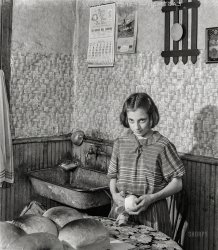
- Sweet Sweeper: 1940
- ... dollars and eighteen cents." Photo by John Collier for the Farm Security Administration. View full size.
Tongue twister Sheila sewed ... Posted by Dave - 05/24/2018 - 6:26am -
![Sweet Sweeper: 1940 Summer 1940. Washington, D.C. "Modeling blue dress made from sugar sacks, designed for a high school girl on a low income by graduate students of the Department of Clothing and Textiles, School of Home Economics, University of Alabama. Total cost of materials was three dollars and eighteen cents." Photo by John Collier for the Farm Security Administration. View full size.
Tongue twisterSheila sewed a shapely summer smock from six sugar sacks.
I would wear that dress!But wow, $3.18 in 1940, adjusted for inflation, is $56 today! And that's just the materials! It's astonishing how cheap clothes have gotten.
Not that cheapAlthough designed for a low-income girl, $3.18 was quite a bit of money in 1940. The minimum wage in 1940 was 30 cents an hour, meaning that one would have to work over 10 hours for the cost of the supplies for one dress. Using the consumer price index, the cost of materials would be about $56 today.
That being said, it takes a lot of talent to look at some sugar sacks and say "I think I can make a dress out of these."
[Most of that $3.18 was the cost of the sugar (over 60 pounds' worth, maybe a year's supply), dress or no dress. And three bucks for a dress in 1940 was cheap, the price of a bra or pair of pajamas. "Economy" dresses in the big department stores were $8. - Dave]
Not a Blue DressIt's obviously Gold.
Pretty PrintsIn the 30s and 40s my great grandfather was an executive in the Chase Bag Company, Milwaukee, Wis.
They produced cloth bags for feed companies printed with patterns. When empty, these bags could be washed and made into shirts, dresses and so on.
I remember as late as the late 50s wearing shirts made by my mother out of these "pretty prints."
Here's an article on the practice.
Skilled SewingWhat a sweet photo. And it's a pretty, well-made dress. So many women and girls then were skilled home sewers.
The Back StoryThose sacks could make a nice photographic backdrop, too.
(The Gallery, D.C., John Collier, Pretty Girls)](https://www.shorpy.com/files/images/SHORPY-8b15153a.thumbnail.jpg)
- The Apprentice: 1939
- ... value. The group was formed with the aid of the Farm Security Administration." Medium format negative by Arthur Rothstein for the ... Posted by Dave - 01/23/2018 - 9:56pm -
![The Apprentice: 1939 November 1939. Black Hawk County, Iowa. "In the past, most milk testing associations have been formed by farmers in the higher-income brackets. This milk-tester works for an association of low-income farmers who heretofore have either lacked the necessary funds or have been unaware of such associations' value. The group was formed with the aid of the Farm Security Administration." Medium format negative by Arthur Rothstein for the FSA. View full size.
Milkfat TestingThe gentleman is performing a Babcock test to determine the fat content of the milk. The device in the right of the photo is a centrifuge for separating the fat from the water and sulfuric acid that he previously added. The fat floats into the tube neck, where he can directly measure its percentage.
Milk Tester?I think you mean Milk testers, the apprentice has some assistants.
[Um, the apprentice is the kitten. - Dave]
Most important of allThe kittens are there for the vital taste test!
Cat controversyThe age-old symbol of a cat happily lapping up a bowl of milk may have been perpetuated by unknowing, non-scientific poets, writers and Mother Goose fans, but for the past fifty years or so, we have been told by veterinarians and cat experts that cats should drink only water after they have been weaned off their mom's milk unless you buy them cat milk, which is an actual product sold in pet shops, etc. as a rare and only occasional treat (but not regularly).Just like lactose-intolerant humans, cats usually cannot handle the lactose and some other elements in milk and may suffer gastro-intestinal problems from drinking it. Some of the results of their stomach distress are not pretty and the cat suffers pain and discomfort too. This was told to me by a veterinarian and I realize that some people do not buy into this, but that's my story and I'm sticking to it.
Dee-lighted!As a current dairy farm worker and former milk tester (nowadays rebranded as "DHIA technician") I was beyond thrilled to see this pic! Thanks, Shorpy!
(The Gallery, Agriculture, Arthur Rothstein, Cats, Rural America)](https://www.shorpy.com/files/images/SHORPY-8b19137a.thumbnail.jpg)
- The Dirt Show: 1937
- ... Medium format acetate negative by Arthur Rothstein for the Farm Security Administration. View full size.
A double button mic. That ... Posted by Dave - 07/13/2021 - 6:39pm -
![The Dirt Show: 1937 November 1937. "Radio microphone used in information work. United States Department of Agriculture." The subject here seems to be soil conservation. Medium format acetate negative by Arthur Rothstein for the Farm Security Administration. View full size.
A double button mic.That appears to be a Western Electric 600A carbon microphone.
https://www.radiomuseum.org/r/western_el_carbon_microphone_600a.html
The other brotherThe names on the script appear to be "SALISBURY" and "EISENHOWER." The former is no doubt Morse Salisbury, radio chief of the Department of Agriculture. But Eisenhower? It's worth remembering that the future president's younger brother Milton served as Director of Information for the U.S. Department of Agriculture from 1928 to 1941. Thereafter, he was president of KSU, then PSU, and (much later) Johns Hopkins.
[He's mentioned by name in the script: "How about it, Milton?" - Dave]
Soil Washing?Wonder what they meant by soil washing, all the present day references I can find are in regards to soil pollutant removal.
["Soil washing" is erosion. - Dave]
Great microphone!I'm a radio guy and love this photo!
Many years ago I played the radio announcer in The Man Who Came to Dinner, and we mocked up a prop mic out of a lap lens ring, some black lace, and a few wires and a coat hanger. This is what it was supposed to look like!
(Technology, The Gallery, Agriculture, Arthur Rothstein, D.C.)](https://www.shorpy.com/files/images/SHORPY-8b20191a.thumbnail.jpg)
- Coke and a Burger: 1938
- ... full size. 35mm nitrate negative by Russell Lee for the Farm Security Administration. You want fries with that?
Ella Cinders Ella ... Posted by Dave - 06/03/2008 - 9:59am -
![Coke and a Burger: 1938 October 1938. "Making hamburgers in the concession stand at the National Rice Festival. Crowley, Louisiana." View full size. 35mm nitrate negative by Russell Lee for the Farm Security Administration. You want fries with that?
Ella CindersElla Cinders was a daily comic strip that ran from 1925 to 1961. It spawned a movie and a short-lived comic book series, which the advertisement is probably promoting. Just the thing to read with a "Tasty" Coca-Cola or a "Twice as Good" RC. The movie advertised in the back is Spawn of the North.
[The ad is for Pan-Am motor oil. - Dave]
Ella CindersYou can see a good number of Ella Cinders strips at Barnacle Press.
Here.
Pan-Am Motor OilPan-Am was the Louisiana arm of American Oil Company, which in turn was owned by Standard Oil of Indiana. It went by the name Amoco until it merged with BP. Louisiana's native Standard Oil of Louisiana was wholly owned by Standard Oil of New Jersey, Esso, which is now ExxonMobil.
The MoviesTo our left of the Pan-Am Oil sign is a pretty large ad for the movie "Spawn of the North" (1938) starring George Raft, Henry Fonda and Dorothy Lamour - none of whose names is on the part of the poster that we can see. What is on the poster (and readable) are the names Akim Tamiroff, Barrymore,Platt, and Overman. They would be John Barrymore, Louise Platt and Lynne Overman. The movie is the exciting tale of two friends caught on either side of a conflict in the Alaskan salmon fishery. One of the roles that Raft didn't turn down.
(The Gallery, Eateries & Bars, Russell Lee)](https://www.shorpy.com/files/images/8a23967u_0.thumbnail.jpg)
- Herb Doctor: 1939
- ... Medium format negative by Marion Post Wolcott for the Farm Security Administration. View full size.
She's purty Even the ... Posted by Dave - 04/22/2021 - 6:49pm -
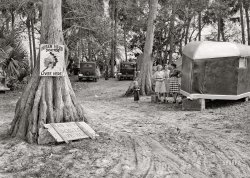
- Etowah County Courthouse: 1940
- ... Medium format acetate negative by John Vachon for the Farm Security Administration. View full size.
7 Years From Tear Down This ... Posted by Dave - 01/22/2020 - 5:40pm -
![Etowah County Courthouse: 1940 December 1940. "Courthouse. Saturday afternoon. Gadsden, Alabama." Medium format acetate negative by John Vachon for the Farm Security Administration. View full size.
7 Years From Tear DownThis building is gone, ripped down for a W.T. Grant. (Streetview tells me that the W.T. Grant was replaced by a bank.) The current courthouse is that governmental moderne that can be kind of cool.
See https://npgallery.nps.gov/GetAsset/b4e22dfc-3041-4c82-98b4-38d7c6652942 for info on the location of the old courthouse and the impact of its removal on the neighborhood.
Christmas shoppers?At bottom center, we can see a couple with their Gadsden Purchase.
But how's the pizza there?I have a good friend from Etowah County. He's from Attala, a town just west of Gadsden, and always refers to himself as an "Attalian."
Hometown CourthouseI'm happily surprised to see my little hometown on Shorpy! This building is demolished, unfortunately. It was replaced in the '50s with a more streamlined courthouse designed by Paul W. Hofferbert for which we have some of the original pencil on vellum drawings here in our architecture office.
One Busy CourthousePutting together December + Saturday + garlands on the wires + folks carrying packages, I think the crowds are more likely doing holiday shopping than having business in the courthouse.
Leg Braces and WheelchairCrossing the street at the lower left. Almost certainly a polio victim. People have forgotten what toll that disease took in those days.
Civil defense sirens?Probably not. But what are those four horns on the rooftop?
[It's a floral finial. - Dave]
(The Gallery, Cars, Trucks, Buses, John Vachon, Small Towns)](https://www.shorpy.com/files/images/SHORPY-8c18569a.thumbnail.jpg)
- Are You in the Possession?
- ... View full size. 35mm nitrate negative by Edwin Rosskam, Farm Security Administration.
"Sub" Marching? I assume they meant ... Posted by Dave - 09/08/2011 - 7:31pm -
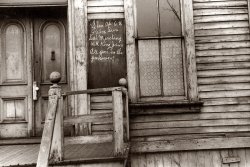
- Extra Starch: 1940
- ... and weighed." 35mm Kodachrome by Jack Delano for the Farm Security Administration. View full size.
Starch factory or train depot? ... Posted by Dave - 05/17/2016 - 12:48pm -
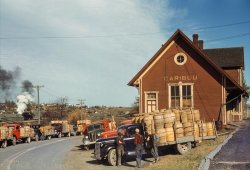
- Questa: 1939
- ... Medium format acetate negative by Russell Lee for the Farm Security Administration. View full size.
Indian(a) Gasoline, father of ... Posted by Dave - 06/19/2018 - 11:25am -
![Questa: 1939 September 1939. "Street scene. Questa, New Mexico." One last look at the business district of this bucolic burg before we motor west. Medium format acetate negative by Russell Lee for the Farm Security Administration. View full size.
Indian(a) Gasoline, father of TexacoIndian Refining Company was one of the ancestors of Texaco. I found this page with a history of Indian Asphalt/Indian Refining of Indiana (only sort of), Havermeyer Oil (the creators of Havoline motor oil), and Texaco in all its variations.
Given how Indian and Texaco's histories are intertwined, I'm not the least surprised to find an Indian pump installed at a station sporting a Texaco sign.
Indian GasThe nearer pump globe sports an "Indian Gas" logo. Who has the dope on Indian brand gasoline? Bet those globes fetch a few bucks today.
Am I seeing right?Does the sign by the hood of the car really read "MONEY FOR SALE"?
[No, honey. - Dave]
Tivoli BreweryFounded in 1859, closed in 1969, and reopened in 2016 in its original Denver location.
If These Shabby, Flimsy Walls Could Only TalkThey might say a few things about a rough little town. Excerpt from Another Time in This Place: Historia, Cultura y Vida en Questa (2003) by Tessie Rael y Ortega and Judith Cuddihy:
"“At this time [1943], Questa had the most despicable reputation with anyone else. So Father Smith decided to do something. One day he got an axe and starting tearing down the bridge, the only way out of town. When people saw what he was doing, they were furious. They said, “What are you doing that for?” And Father Smith said, “If I don’t tear down the bridge, it’ll fall down.” The people said, “In that case, we’ll help you.” So they tore it down and then they realized what they had done. “Now we can’t get out of town,” they said. Father Smith said, “I guess you’ll have to build another one.” And they did.
Father Smith lived in a house on top of a hill where the Parish Hall is now located. From there he could see everything that was going on in town—who was fighting, who was hanging out in bars, and so forth. One day he had a police siren mounted on top of his car. Whenever he saw a disturbance, he’d turn on the siren and go down. He said to them, “Did you see it? Did you hear it? Then swallow it.” He succeeded in remodeling Questa. Two years later it won a prize for civil cooperation.”
Lunch SuppliesThe typeface on the Groceries sign looks very modern and a bit out of place compared to the others. Is it neon?
Sipping Four Roses at the Four Roses.That step just outside the door of the Four Roses Cafe seems like it would be trouble for a sober man but a man full of Four Roses Bourbon served by the saucy redheaded Four Roses barmaid would defy gravity and blessed drunkenness if he were able to navigate it and steer a homeward bound course.
(The Gallery, Gas Stations, Russell Lee, Stores & Markets)](https://www.shorpy.com/files/images/SHORPY-8b22880a.thumbnail.jpg)
- Etna: 1941
- ... Medium format acetate negative by John Vachon for the Farm Security Administration. View full size.
No Known Limit to John ... Posted by Dave - 09/06/2020 - 2:23pm -
